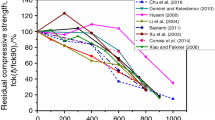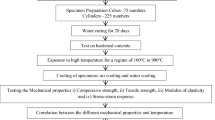Abstract
Concrete is often damaged on exposure to fire causing significant loss in strength. Although the subject has been extensively investigated, the physics of fire damage is still not known exactly, especially the effect of water inside concrete that can evaporate, causing internal pressure and cracking. This paper explores the influence of some practical cases of moisture states on the performance of concrete after exposure to heating. This research focusses on the effect of three moisture states, namely, dry, saturated, and moist, on the behavior of normal and high strength concretes (NSC and HSC) at high temperatures. As the moisture states may be dependent on the size of concrete specimens, two sizes of cylinders of 150 × 300 and 100 × 200 mm were used. The moisture states were differentiated in terms of unit weight, weight loss, and relative humidity inside concrete. The relative humidity was measured at different depth of concrete cylinder to establish the variation of moisture inside concrete test specimens. The exposure temperatures were: ambient, 300 °C, and 600 °C. The condition of test specimens after heating was assessed in terms of cracks, spalling, and compressive strength. Although no effect of moisture could be observed at 300 °C, significant effect of moisture was noted at 600 °C with the almost dry conditions being the most favorable in minimizing the strength loss.














Similar content being viewed by others
References
Abbas, H.; Al-Salloum, Y.A.; Elsanadedy, H.M.; Almusallam, T.H.: ANN models for prediction of residual strength of HSC after exposure to elevated temperature. Fire Saf. J. 106, 13–28 (2019)
Ahmed, G.N.; Hurst, J.P.: Modeling pore pressure, moisture, and temperature in high-strength concrete columns exposed to fire. Fire Technol. 35, 232–262 (1999)
Ichikawa, Y. (2000). Prediction of pore pressures, heat and moisture transfer leading to spalling of concrete during fire. Ph.D. Thesis
Ichikawa, Y.; England, G.L.: Prediction of moisture migration and pore pressure build-up in concrete at high temperatures. Nucl. Eng. Des. 228(1–3), 245–259 (2004)
Li, Y.; Yang, E.H.; Zhou, A.; Liu, T.: Pore pressure build-up and explosive spalling in concrete at elevated temperature: a review. Constr. Build. Mater. 284, 122818 (2021)
Amran, M.; Huang, S.S.; Onaizi, A.M.; Murali, G.; Abdelgader, H.S.: Fire spalling behavior of high-strength concrete: a critical review. Constr. Build. Mater. 341, 127902 (2022)
Hedayati, M.; Sofi, M.; Mendis, P.; Ngo, T.: A comprehensive review of spalling and fire performance of concrete members. Electron. J. Struct. Eng. 15, 8–34 (2015)
Kannangara, T.; Joseph, P.; Fragomeni, S.; Guerrieri, M.: Existing theories of concrete spalling and test methods relating to moisture migration patterns upon exposure to elevated temperatures–a review. Case Stud Construct Mater 16, e01111 (2022)
Schneider, U.: Concrete at high temperatures—a general review. Fire Saf. J. 13(1), 55–68 (1988)
Malik, M.; Bhattacharyya, S.K.; Barai, S.V.: Temperature, porosity and strength relationship for fire affected concrete. Mater. Struct. 55(2), 72 (2022)
Zawadowska, A.; Giuliani, L.; Hertz, K.D.: Experimental study on the mechanical properties of fire exposed concrete. Saf. Sci. 142, 105357 (2021)
Wang, X.; Zhu, P.; Yu, S.; Liu, H.; Dong, Y.; Xu, X.: Effect of moisture content on tunnel fire resistance of self-compacting concrete coated with aerogel mortar. Mag. Concr. Res. 73(20), 1071–1080 (2021)
Wróblewska, J.; Kowalski, R.: Assessing concrete strength in fire-damaged structures. Constr. Build. Mater. 254, 119122 (2020)
Khoury, G.A.: Effect of fire on concrete and concrete structures. Prog. Struct. Mat. Eng. 2(4), 429–447 (2000)
Chan, S.Y.N.; Peng, G.F.; Anson, M.: Fire behavior of high-performance concrete made with silica fume at various moisture contents. Mater. J. 96(3), 405–409 (1999)
Shen, J.; Xu, Q.: Effect of elevated temperatures on compressive strength of concrete. Constr. Build. Mater. 229, 116846 (2019)
Li, P.; Liu, J.; Duan, S.; Huang, R.: Variation pattern of the compressive strength of concrete under combined heat and moisture conditions. Materials 16(4), 1548 (2023)
Kodur, V.: Properties of concrete at elevated temperatures. International Scholarly Research Notices, 2014 (2014)
Ko, J.; Ryu, D.; Noguchi, T.: The spalling mechanism of high-strength concrete under fire. Mag. Concr. Res. 63(5), 357–370 (2011)
Van der Heijden, G.H.A.; Pel, L.; Adan, O.C.G.: Fire spalling of concrete, as studied by NMR. Cem. Concr. Res. 42(2), 265–271 (2012)
Van Der Heijden, G.H.A.; Van Bijnen, R.M.W.; Pel, L.; Huinink, H.P.: Moisture transport in heated concrete, as studied by NMR, and its consequences for fire spalling. Cem. Concr. Res. 37(6), 894–901 (2007)
Iwama, K.; Kato, Y.; Baba, S.; Higuchi, K.; Maekawa, K.: Accelerated moisture transport through local weakness of high-strength concrete exposed to high temperature. J. Adv. Concr. Technol. 19(2), 106–117 (2021)
Shen, L.; Monte, F.L.; Di Luzio, G.; Cusatis, G.; Li, W.; Felicetti, R.; Ren, Q.: On the moisture migration of concrete subject to high temperature with different heating rates. Cement Concr. Res. 146, 106492 (2021)
Eurocode 2: EN 1992–1–2 (2010). Design of Reinforced and Prestressed Concrete Structures, Part 1–2: General Rules–Structural Fire Design, European Committee for Standardization.
ASTM F2170–19 (2019). Standard Test Method for Determining Relative Humidity in Concrete Floor Slabs Using in situ Probes. ASTM International, West Conshohocken, PA, 2019.
ASTM C39/C39M: Standard Test Method for Compressive Strength of Cylindrical Concrete Specimens. ASTM International, West Conshohocken, PA, 2017 (2018)
Preston, F.W.; White, H.E.: Observations on spalling. J. Am. Ceram. Soc. 17(1–12), 137–144 (1934)
Breunese, A.J., & Fellinger, J.H.H.: Spalling of Concrete–An Overview of Ongoing Research in the Netherlands. In Proceedings of the Third International Workshop: Structures in Fire, Ottawa, Canada (pp. 249–258) (2004)
Jansson, R.; Boström, L.: The influence of pressure in the pore system on fire spalling of concrete. Fire Technol. 46(1), 217 (2010)
Naus, D.J.; Graves, H.L., III.: A review of the effects of elevated temperature on concrete materials and structures. Int. Conf. Nuclear Eng. 42428, 615–624 (2006)
Wu, G.; Teng, N.G.; Wang, Y.: Physical and mechanical characteristics of limestone after high temperature. Chin. J. Geotechn. Eng. 33(2), 259–264 (2011)
Khan, M.S.; Abbas, H.: Performance of concrete subjected to elevated temperature. Eur. J. Environ. Civ. Eng. 20(5), 532–543 (2016)
Abadel, A.; Elsanadedy, H.; Almusallam, T.; Alaskar, A.; Abbas, H.; Al-Salloum, Y.: Residual compressive strength of plain and fiber reinforced concrete after exposure to different heating and cooling regimes. Eur. J. Environ. Civ. Eng. 26(14), 6746–6765 (2022)
Dougill, J.W.: Modes of failure of concrete panels exposed to high temperatures. Mag. Concr. Res. 24(79), 71–76 (1972)
Khan, M.S.; Abbas, H.: Effect of elevated temperature on the behavior of high volume fly ash concrete. KSCE J. Civ. Eng. 19, 1825–1831 (2015)
Khan, M.S.; Prasad, J.; Abbas, H.: Effect of high temperature on high-volume fly ash concrete. Arab. J. Sci. Eng. 38, 1369–1378 (2013)
Schneider, U.; Diederichs, U.; Ehm, C.: Effect of temperature on steel and concrete for PCRV’s. Nucl. Eng. Des. 67(2), 245–258 (1982)
Jansson, R., & Boström, L. (2009, September). Fire spalling-the moisture effect. In 1st International workshop on concrete fire spalling due to fire exposure, MFPA Institute, Leipzig, Germany, September 3–5, 2009, pp 120–129.
Maier, M.; Zeiml, M.; Lackner, R.: On the effect of pore-space properties and water saturation on explosive spalling of fire-loaded concrete. Constr. Build. Mater. 231, 117150 (2020)
Kirchhof, L.D.; Lima, R.C.A.D.; Santos Neto, A.B.D.; Quispe, A.C.; Silva Filho, L.C.P.D.: Effect of moisture content on the behavior of high strength concrete at high temperatures. Matéria (Rio de Janeiro) 25, 898 (2020)
Bentz, D.P.: Fibers, percolation, and spalling of high-performance concrete. Mater. J. 97(3), 351–359 (2000)
Lankard, D.R.; Birkimer, D.L.; Fondriest, F.F.; Snyder, M.J.: Effects of moisture content on the structural properties of portland cement concrete exposed to temperatures up to 500F. Spec. Publ. 25, 59–102 (1971)
Noumowe, A.N.; Clastres, P.; Debicki, G.; Costaz, J.L.: Transient heating effect on high strength concrete. Nucl. Eng. Des. 166(1), 99–108 (1996)
Acknowledgements
The authors extend their appreciation to the Deputyship for Research & Innovation, Ministry of Education in Saudi Arabia for funding this research (IFKSURC-1-2213).
Author information
Authors and Affiliations
Corresponding author
Rights and permissions
Springer Nature or its licensor (e.g. a society or other partner) holds exclusive rights to this article under a publishing agreement with the author(s) or other rightsholder(s); author self-archiving of the accepted manuscript version of this article is solely governed by the terms of such publishing agreement and applicable law.
About this article
Cite this article
Abbas, H., Abadel, A., Alaskar, A. et al. Effects of Moisture on Properties of Concrete Exposed to Elevated Temperature. Arab J Sci Eng (2024). https://doi.org/10.1007/s13369-024-09012-7
Received:
Accepted:
Published:
DOI: https://doi.org/10.1007/s13369-024-09012-7




